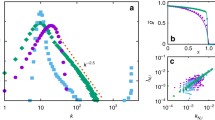Abstract
A new learning mechanism is proposed for networks of formal neurons analogous to Ising spin systems; it brings such models substantially closer to biological data in three respects: first, the learning procedure is applied initially to a network with random connections (which may be similar to a spin-glass system), instead of starting from a system void of any knowledge (as in the Hopfield model); second, the resultant couplings are not symmetrical; third, patterns can be stored without changing the sign of the coupling coefficients. It is shown that the storage capacity of such networks is similar to that of the Hopfield network, and that it is not significantly affected by the restriction of keeping the couplings' signs constant throughout the learning phase. Although this approach does not claim to model the central nervous system, it provides new insight on a frontier area between statistical physics, artificial intelligence, and neurobiology.
Similar content being viewed by others
References
W. A. Little,Math. Biosci. 19:101 (1974).
J. J. Hopfield,Proc. Natl. Acad. Sci. U.S.A. 79:2554 (1982).
D. J. Amit, H. Gutfreund, and H. Sompolinsky,Phys. Rev. A 32:1007 (1985);Phys. Rev. Lett. 55:1530 (1985).
P. Peretto,Biol. Cybern. 50:51 (1984).
L. Personnaz, I. Guyon, and G. Dreyfus,J. Phys. Lett. 46:L359 (1985).
W. Kinzel,Z. Phys. B 60:205 (1985).
N. Parga and M. A. Virasoro, to be published.
G. Toulouse, S. Dehaene, and J. P. Changeux,Proc. Natl. Acad. Sci. U.S.A., to be published.
N. Jerne, inThe Neurosciences: A Study Program, G. Quartonet al., eds. (The Rockefeller University Press, New York, 1967).
J. P. Changeux, T. Heidmann, and P. Patte, inThe Biology of Learning, P. Marler and H. Terrace, eds. (Springer-Verlag, New York, 1984).
K. H. Fischer,Phys. Stat. Sol. (B) 116:357 (1983); see also: “Heidelberg Colloquium on Spin Glasses,”Lecture Notes in Physics, No. 192 (Springer-Verlag, New York, 1983).
A. Albert, inRegression and the Moore-Penrose Pseudoinverse (Academic Press, New York, 1972).
Author information
Authors and Affiliations
Rights and permissions
About this article
Cite this article
Personnaz, L., Guyon, I., Dreyfus, G. et al. A biologically constrained learning mechanism in networks of formal neurons. J Stat Phys 43, 411–422 (1986). https://doi.org/10.1007/BF01020645
Received:
Revised:
Issue Date:
DOI: https://doi.org/10.1007/BF01020645




